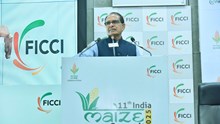
It is well known that the agricultural sector provides a significant contribution towards Indian economy. Irony is that this sector continues facing several challenges, such as old laws governing agricultural marketing and price discovery mechanisms, ultimately resulting in decrease in realization of prices by the local growers or the farmers. Despite large contributions to the Indian economy, our agriculture suffers from lots of problems, one of them being relatively lower yields than most nations. Other crucial issue is that most of the planted areas are solely dependent on the timely arrival of monsoon.
The quantity as well as distribution of rainfall is crucial for farm output, since more than 50% of the area under cultivation depends on rainfall. Even those areas which have irrigation facility also have problems due to over usage of groundwater, leading to fall in groundwater level. The country loses good percentage of crop output produced every year, mainly because of lacking adequate warehousing and cold storage facilities.
Reports say that farmers cannot sell directly to ultimate buyers such as processors, exporters and retailers, on account of the APMC Act. This forces the farmers to sell their produce to traders or local aggregators. Processors, exporters, and retailers in turn buy from local aggregators. This implies increase in the number of intermediaries, hence problem of rise in costs emerge. Also, there is a lack of standardization across the regulated market yards, in terms of quality or other costs. Due to all such problems, price variations in a single variety is wide across different states/trading centers.
After the inception of national commodity exchanges, Indian commodity market has made notable progress; also lowered the problems associated with farm produce, or addressed underlying problems of the farmers to a large extent. A well-developed commodities futures market is an advantage for farmers to predict their earnings and plan their future investments accordingly. A commodity exchange serves as a platform for efficient price discovery and risk management.
Commodity exchanges have played an important role in creating an environment that enabled farmers and other market participants to grow their business with utmost confidence and trust. This was possible through driving numerous reforms by these exchanges. Earlier there were other Agri commodity exchanges like NBOT/IPSTA etc but now there are two nationalized exchanges viz. NCDEX and MCX with NCDEX leading in futures trading of Agricultural commodities.
Exchanges like NCDEX’s Electronic mode of trading and standardized quality and quantity parameters of futures contracts have helped to establish a centralized market place accessible to market participants on real-time basis, ignoring locations across the country. Evolution of commodity futures market has also only necessitated the development of storage and warehousing infrastructure. Farmers every year are prone to the risk of uncertainty over price fluctuations of their produce in medium or longer term hence futures platforms provide them a tool to offset this price risk by hedging their produce. Hedging is a strategy involved in futures markets or a sort of insurance against protecting oneself against abnormal or unusual price changes or minimizing the price risk.
In other words hedging is a process of transferring one’s price risk to other participants who are willing to take it. As exchanges are platforms for price discovery and hedging, they are beneficial in offering income security to farmers. A valid example for national exchange like NCDEX, where availability of futures trading in guar seed/guar gum has been proved to be an important factor, for enhancing guar gum export from India.
NCDEX’s agricultural commodity futures are highly correlated to respective spot prices and that makes NCDEX futures perfect tools for hedging commodity price risk for market participants. This is because Hedging with futures require an almost perfect or a high positive correlation between the spot price and the price of future contracts. In case of imperfect correlation, there would be mismatch between gains and losses from both markets, eventually enhancing the price risk known as the Basis risk (Basis is the difference between futures and spot prices).

For better participation in futures trading and efficient hedging, liquidity of the future contract is an important feature. Most of NCDEX Agri-futures like Guar/Guar Gum, soybean, cotton oil cake, mustard seed, soya oil and Chana have been very liquid at the Exchange thus making them the best hedging tool available in the country for Agricultural crops/commodities.
Futures trading have also helped in improving the economy of the warehouse industry also. Warehouses play an important role in commodities futures as most of trades are settled by delivery. As NCDEX’s focused on promoting the delivery business deliveries, this resulted in establishment of more number of warehouses across India. This was clearly reflected in the state of Bihar, which is a key production centre for Maize. NCDEX had launched a Maize futures contract with Gulabbagh as the basis centre, which encouraged large companies to invest in developing storage infrastructures. As a result, bargaining power of farmers has improved in relevant areas of the state.
In order to enable the facility of maintain record of commodities in the approved warehouses (for the purpose of delivering on the Exchange platform), NCDEX has developed a unique electronic accounting system known as Comtrack. This facility tracks the movement of goods in the warehouse ecosystem of the exchange, in addition to providing a concrete idea to the lenders, from a single window.
All these operations require capital involvement, for which NCDEX has tied up with leading banks and NBFCs to promote financial inflows through an electronic pledge facility that will enable farmers and traders to use their commodities stored in an approved warehouse as financial assets. Customers/corporate/farmers, who want to avail pledge finance through deposit their goods in exchange approved warehouses. Comtrack facility is useful in providing transparency and tracking of commodities in approved warehouses, giving comfort to the banks – this is welcomed by the industry as a single biggest game changer for the industry.
Agricultural commodity market, which is organized and well-developed, shall be benefitting farmers to evaluate their future incomes and also plan their future course of action for investments. Data suggests that after introduction of futures’ trading of agricultural commodities at NCDEX, there has been significant reduction price volatility. Now farmers to large extent, are able to get fair and remunerative prices of agricultural produce, which had been a major challenge in past.
By September 2019 NCDEX had successfully added FPO’s, covering nearly 4.6 Lakh farmers from the group. Total states covered were 13 and reportedly most farmers of Madhya Pradesh, Bihar, and Rajasthan were able to receive nearly 20% higher farm-gate prices for wheat, maize, mustard seed, and soybean, which were actively hedged on NCDEX.
Since NCDEX is regulated by SEBI, Confidence has improved amongst farmers and the Farmer Producer Companies to large extent in recent years. This shall continue encouraging participation from their end, subject to government intentions to bring in lucrative schemes or policy related announcements for encouraging the Farmers or the FPO’s to trade in the futures or derivative markets.
Already signs are emerging from the recently announced 20 Lakh crore economic package on Agriculture, indicating possible refinement in the Agricultural norms, specially de-regulation of oilseeds cereals, edible oils, pulses, onions and potato. It is quite possible that in near future more number of farmers shall be able to divert themselves from subsistence farming to market-oriented agriculture from by participating in the futures market, which would enable them to assess the price outlook before planting begins, and managing price risk at harvest time. Other forms of support from futures trading at exchanges shall be post-harvest training on quality standards, financing and warehousing. The grass is definitely green under present circumstances – surely further streamlining of rules ®ulations/policies etc, and co ordination between Government departments, exchanges or financial experts can be a game changer for the country’s economy as well as improving farmers’ income all in all.















